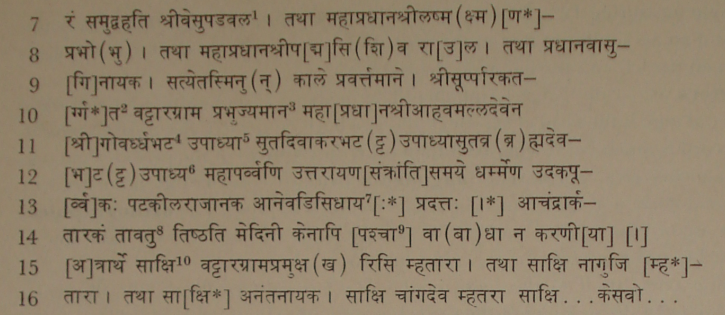|
The Indian Analyst
|
North Indian Inscriptions |
INSCRIPTIONS OF THE SILAHARAS OF NORTH KONKAN
TRANSLATION ..Success ! Hail ! May there be victory and prosperity ! .. In the expired year ten hundred augmented by seventy-two, in figures, the year 1072, by the era of the Śaka king, the cyclic year being Pramōda, on Mārgaśīrsha śuddha 1—on the aforementioned tithi—today, here, during the beneficial and victorious reign of the Mahāmaṇḍalēśvarādhipati, the illustrious Haripāladēva, who has acquired the right to all the five mahāśabdas (and) who is adorned with all the royal titles (such as) ‘the illustrious Śilāhāra king (and) ‘(he) who is born in the family of Jīmūtavāhana’, while the following ministers are bearing the burden of the whole maṇḍala entrusted to them by his grace, (viz.) the illustrious Vēsupaḍavala, and the Mahāpradhāna, the illustrious Lakshmaṇaprabhu and the Mahāpradhāna, the illustrious Padmaśiva Rāula and the Pradhāna Vāsugināyaka, at this time the Mahāpradhāna, the illustrious Āhavamalladēva, who is enjoying the village Vaṭṭāra included in the famous Śūrpāraka, has donated the revenue of (the hamlet) Ānēvāḍī, belonging to the Paṭakila Rājānaka, to Brahmadēvabhaṭṭa Upāddhyāya, the son of Divākarabhaṭṭa Upādhyāya, who is (himself ) the son of the illustrious Gōvardhanabhaṭṭa Upādhyāya, piously with the pouring out of water, on the great auspicious occasion of the Uttarāyaṇa-saṅkranti. .. (Line 13) None should causes any obstruction hereafter as long as the moon, the sun and the stars (continue to shine), and the earth endures. .. To this (gift) the following are witnesses—Risi mhātāra, the chief of the village Vaṭṭāra, and Naguji mhātārā, and Anatanāyaka, (and) Chāngadēva mhātārā and …Kēśava.
No. 26 : PLATE LXIV ..THIS stone inscription was found at Māhul near Trombay in 1958, and is now preserved in the godown of the ESSO refinery at the place. It was edited by Dr. M. G.
Dikshit in the Epigraphia Indica, Vol. XXXVII, pp. 165 f. with a plate. It is edited here
from the same plate.
[1] This and the following personal names should be in the locative so as to agree with समुद्वहति.
|
|||||||||||||||||||||||||||||||||||||||||||||||||||||||||||||||||||||||||||||||||||||||||||||||||||||||||||||||||||||
| > |
|
>
|








